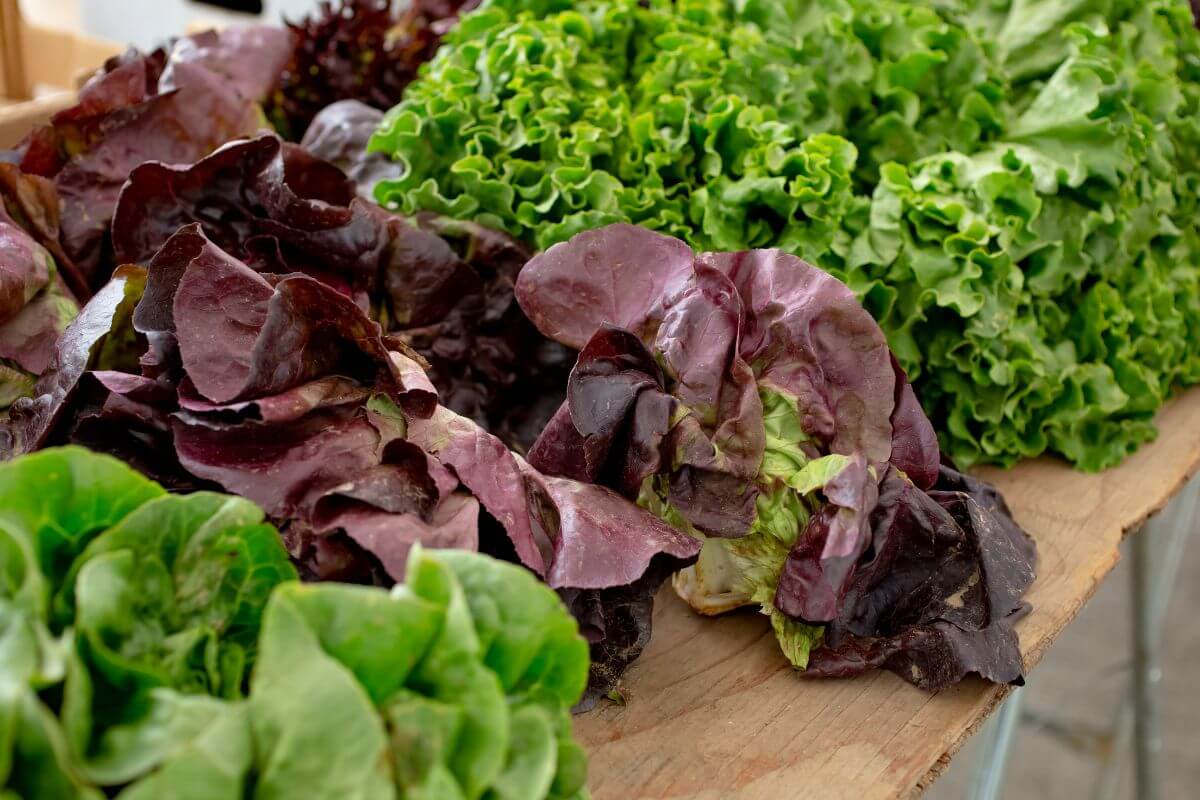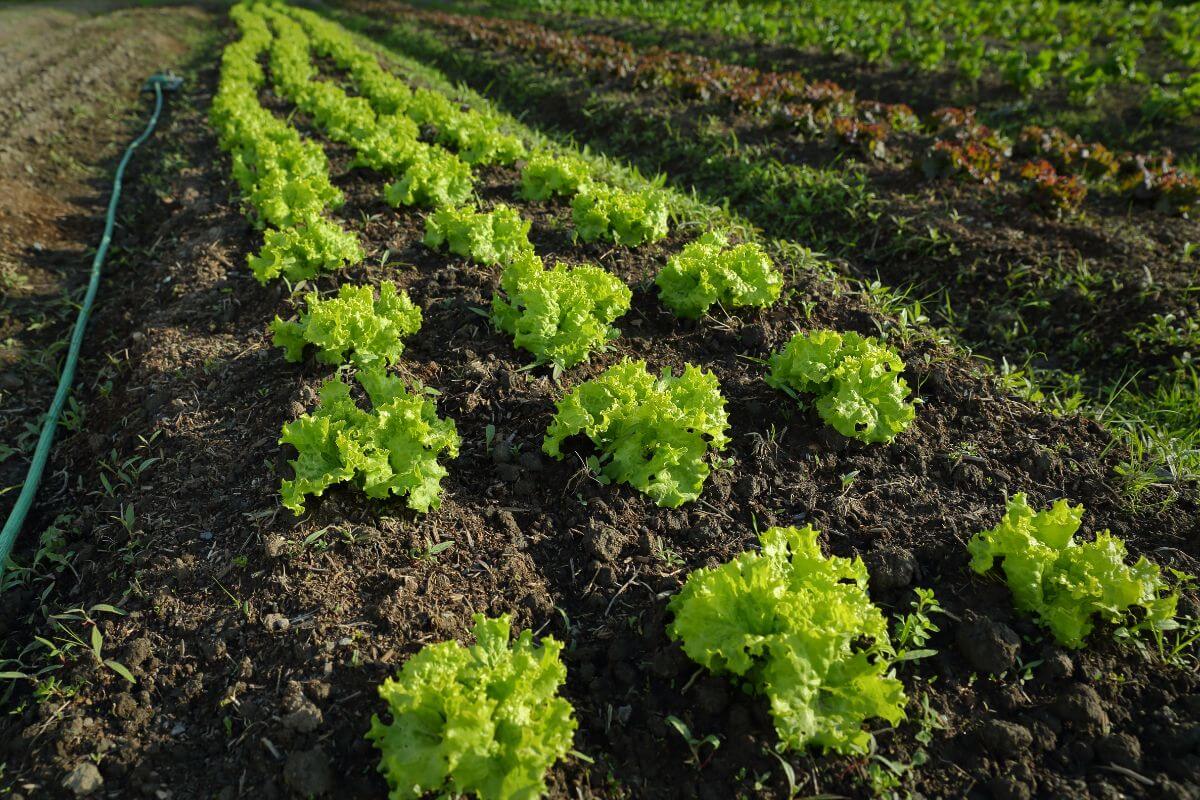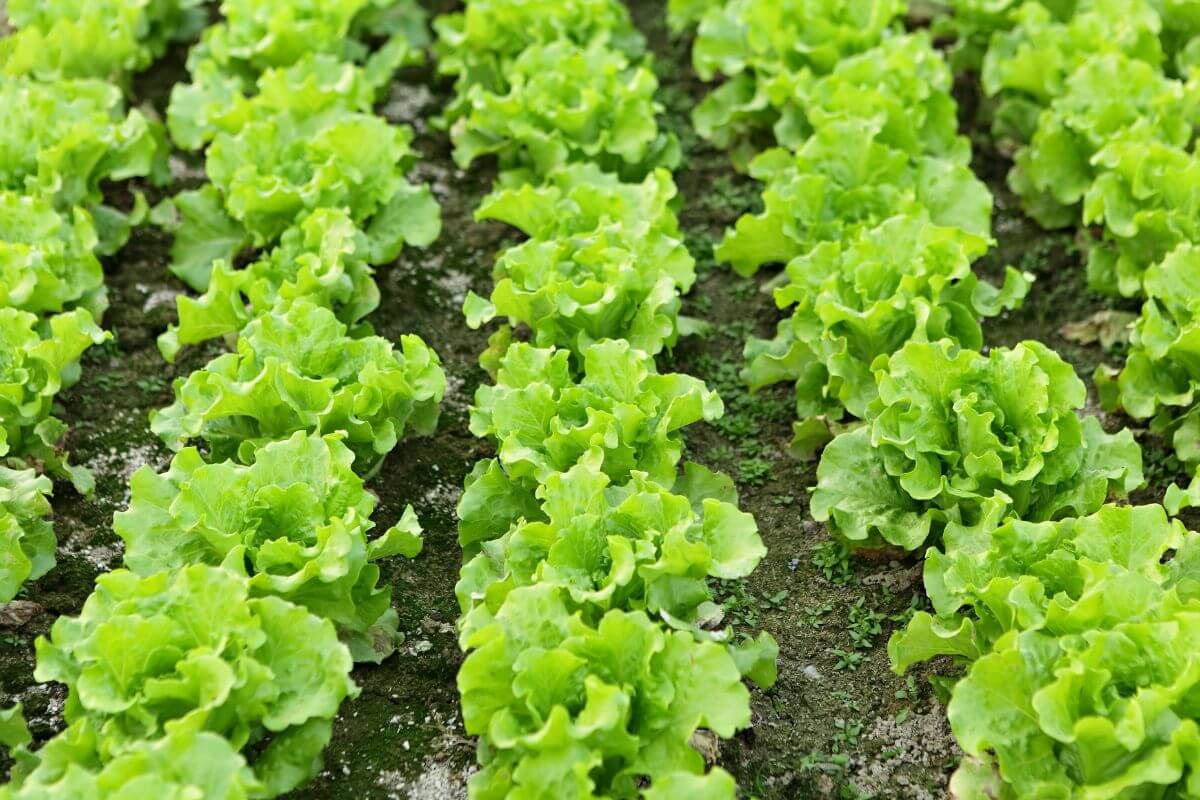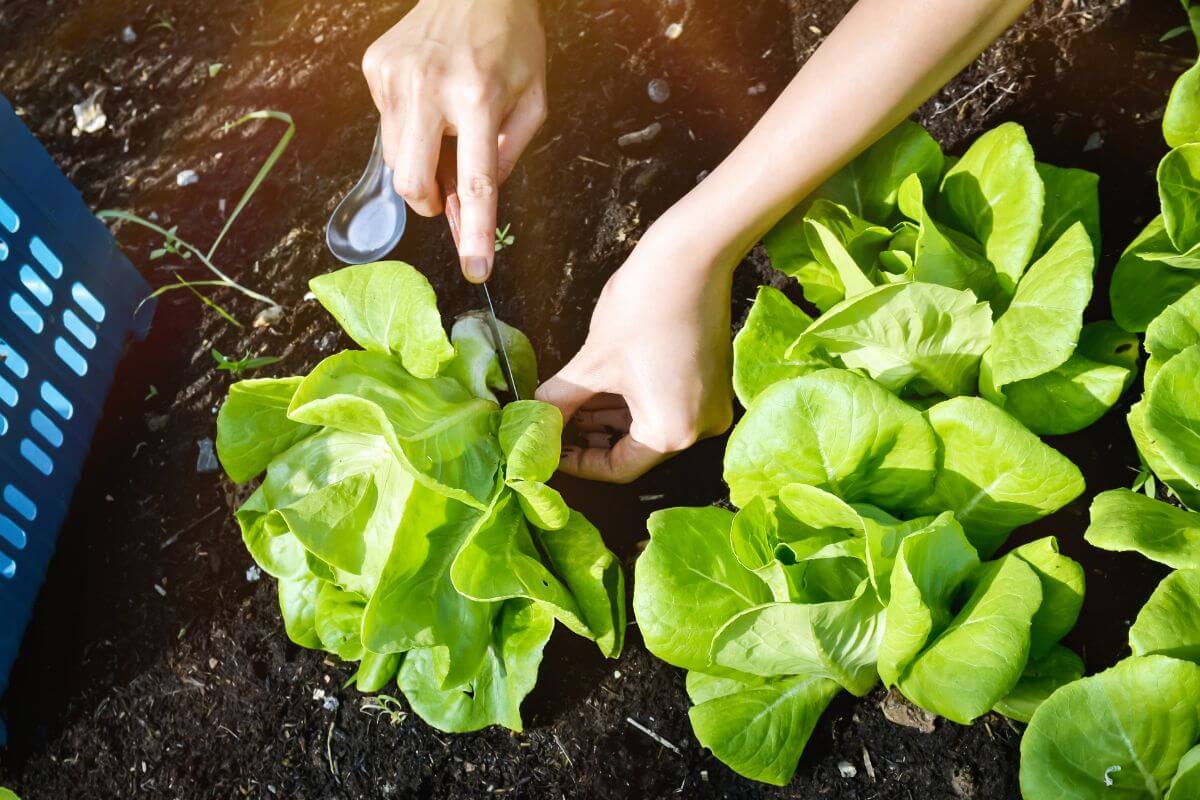Lettuce is pretty easy vegetable to grow, but you will find competition for your crops. Pests will be your main concern growing lettuce, but they are still quite straightforward to deal with.
This article goes through how to grow organic lettuce, lettuce varieties, care, harvesting, and what pests to look out for.
- Related Article: Guide to Starting an Organic Garden
Lettuce Varieties

There are hundreds of types of lettuce out there, far too many to list them all here. I’m going to go through the most common categories that lettuce varieties fall into, and detail some of their qualities to help you pick which ones you might want to grow.
Lettuce is often over overlooked when it comes to nutrition. While everybody recognizes that it isn’t bad for you, what most people don’t realize is how much good it really does.
Lettuce has next to no calories, but is packed full of fiber, vitamins, minerals and phytochemicals. Its contains folate that makes and repairs DNA in cells, and vitamin K that aids in keeping bones healthy. Studies have also shown it lowers cholesterol, and has anti-inflammatory and anti-diabetic properties.
Lettuce is self-pollinating, so if you’re seed saving you can viably grow different varieties with a low risk of cross pollination, as long as you don’t grow them all in a small space.
- Iceberg Lettuce – This is probably what most people think of when they hear the word “lettuce.” It has a tightly formed head with crisp, light green leaves and a white, juicy center. These can actually be one of the toughest types to grow as they need long, cold seasons to mature. You can extend the growing season by starting them indoors, and keep them partially shaded during the warmer months.
- Butterhead Lettuce – An attractive lettuce with a loosely formed head and soft tender leaves that have a sweet taste. They don’t travel well and so are rarely seen in the grocery store. You can harvest the whole head or harvest the lettuce leaves throughout the season.
- Green Leaf Lettuce – A semi-frilled loose leaf lettuce. The heads can be harvested at different stages, and can grow to around 1 1/2 pounds if left to reach full size.
- Red Leaf Lettuce – These can be a mix of green and purple leaves, and are pretty similar to green leaf, except for the colors. They are highly nutritious, but the leaves bruise more easily than green leaf varieties.
- Romaine Lettuce – Grows upright with oval leaves. They can be red or green, and have crisp and crunchy leaves. They need a long cool season to grow well, but you are able to harvest the leaves from them while they’re growing.
- Summer Crisp Lettuce – Unlike most varieties, these do well in hot weather. Has thick, flavorsome leaves. This type of lettuce is great if you live in warm climates.
- Oak Leaf Lettuce – Often found in baby lettuce leaf mixes, the leaves have lobes, making them resemble that of the oak tree.
Site and Organic Soil Preparation

Lettuce likes loose, organic nutrient-rich soil. Dig in plenty of organic matter to your soil before planting, and keep your beds topped up with organic compost.
Adding compost and soil amendments like aged manure are great organic material to add to the soil for your lettuce crop.
- Read More: Complete Guide to Organic Soil Amendments
You can also add a 2-3 inch layer of organic mulch to keep the soil cool and help prevent weeds. Organic mulch material can be wood chips or chopped leaves.
The mulch helps to retain moisture, so it doesn’t quickly dry up. This also helps to prevent soil splashing onto the leaves, so it keeps the lettuce clean.
The soil needs to have good drainage and plenty of nitrogen. Raised beds are a simple way to increase the drainage of your soil. To add nitrogen to your soil, use blood meal or nettles.
You can seep nettles in water to make nitrogen-rich plant feed to add to the soil. Give the plant feed to your growing plants about once a week.
Another great organic fertilizer option is fish emulsion. Dilute it and add it to the loose garden soil every couple weeks. Lettuce won’t do well in low-quality soil and a lack of regular water.
Lettuce has shallow roots, usually in the top 3-4 inches of soil, and is ideal to grow in raised beds or containers. If you’re short on space, there are miniature lettuce varieties available that you’ll even be able to grow in a window box or in your kitchen.
Don’t let the young plants get too hot, but lettuces do like about 6 hours of full sunlight per day. If they are exposed to too much heat, they tend to bolt early and go to seed. If you have an unexpected heatwave, you can give them temporary shade with an old bed-sheet.
Planting and Growing Organic Lettuce

Lettuce has a very high germination rate and you can expect about 80% of the seeds you plant to germinate. This does drop depending on how long the seeds have been stored, and can get as low as 50% after the first year.
You can start lettuce off inside around eight weeks before the last frost. Stagger plantings, so you have successive crops throughout the growing season.
As a general rule, plant a few seeds on the same day every week or two. That will allow you to have mature lettuce ready whenever you want them.
Once the last frosts have passed 8 weeks from the first planting, they will be ready to transplant outside. Harden them off by restricting their water and leaving them outside during the day for a few days before planting out.
Take care when transplanting them, as young lettuce is very delicate. Dig a hole about twice the size of the root ball. Gently place the plant in and pack soil around it. Space plants about 12 inches apart for crisphead lettuce and six inches for loose leaf.
You can sow seeds directly outside after the last frosts, or in cold frames about 6 weeks beforehand.
Keep your lettuce well watered and keep an extra eye on them in warm weather. Retain moisture in the soil using mulch, and give them some nitrogen feed once a week.
If you fancy having a go at companion planting, then lettuce can be grown with pretty much anything. It does especially well with root vegetables like carrots, garlic and onions.
Pests and Diseases
Rabbits and groundhogs can devastate your lettuce crops, so build a sturdy fence if there is the possibility that they can get into your garden.
Slugs, snails, aphids, and cabbage worms are also common pests when it comes to lettuce. Check your plants regularly and pull off any of that you find. You can use beer traps or organic pesticides, but it’s much better to use vigilance and natural predators to keep pests under control.
- Read More: Organic Pest Control Complete Guide
Natural predators like frogs and birds eat slugs, snails and other bugs, so consider adding a wildlife pond to your garden space to attract both of these beneficial visitors.
Ladybugs are great natural predators for aphid control, you can use a soap spray. But as lettuce is 95% water, chances are your crops may taste a bit soapy if you use it on lettuce. That’s also why I don’t use organic pest-deterrent sprays.
Lettuce doesn’t suffer from many diseases, but can be affected by bottom rot if the soil stays too wet. Water in the morning to leave time for the leaves to dry, and give your plants plenty of space between them.
Harvest and Store Organic Lettuce

Lettuce can be harvested by the whole head, or you can pick the leaves off a plant as you need them.
Pick the outer leaves by hand throughout the growing season, or cut the head from the stem with a sharp knife about an inch away from the soil.
Always harvest in the morning to make sure you’re getting the leaves when they are at their most crisp.
Lettuce is best eaten fresh, although you can store it for up to two weeks in the refrigerator. Rinse the leaves with water then shake or spin them dry. Keep them in a breathable plastic bag in the fridge and refrigerate immediately for maximum freshness.
If you’ve grown a hardy variety that doesn’t bruise easily, you can also freeze lettuce. Freeze the whole leaves to use as lettuce wraps, or chop it up before you freeze it and use it to make lettuce soup.
Seed saving from lettuce is pretty easy, select the biggest heads to save seeds from and keep in mind that late bolting is a desired trait, so resist the temptation to save seed from any that bolt early in the season.
Although lettuce seeds can last for up to 5 years, the germination rate drops dramatically after the first year. It’s best to use them as soon as you can.
How to Grow Organic Lettuce Final Thoughts
Fresh lettuce really is nothing like the stuff you buy at the grocery store. Even if you don’t think you like lettuce, it’s worth giving growing it a go.
Organic lettuce is full of nutrients and full of flavor when you eat it fresh. It’s also surprisingly versatile. Use large leaves instead of bread wraps, or try a refreshing summer soup.
For other guides on growing organic crops, check these out:
- How to Grow Organic Potatoes
- How to Grow Organic Tomatoes
- How to Grow Organic Kale
- How to Grow Organic Cilantro
- Organic Vegetable Gardening Tips
Growing Organic Lettuce FAQs
What is the best organic fertilizer for lettuce?
The best organic fertilizer for lettuce is composted manure mixed into the top 6 inches of soil. This will help build healthy roots and prevent disease problems. You’ll want to add this mixture every spring and fall.
Is there anything special I should do to grow organic lettuce?
Yes! The key thing here is to avoid using pesticides. If you have trouble controlling weeds, apply some mulch around the base of each plant. And remember to rotate your crop rotation each growing season.
What makes lettuce organic?
There isn’t one specific definition of what makes something “organic.” But generally speaking, things labeled “100% organic” must not contain synthetic fertilizers, herbicides, fungicides, insecticides, or animal products. They may still include genetically modified organisms, which means crops produced through genetic engineering techniques such as gene splicing.
How do you grow organic hydroponic lettuce?
Hydroponics involves growing plants in without dirt. Instead, nutrient rich liquid solution circulates in a container or pipes for plant roots to absorb needed nutrients. There are many different types of hydroponics systems available today. The most popular way is with the AeroGarden indoor garden kits. AeroGardens are popular ways to grow hydroponic lettuce.
Is organic lettuce safe from E. coli?
E.coli bacteria can be found on all kinds of produce, including lettuce. However, organic lettuce has been shown to have lower levels of E.coli than conventional varieties, when the organic produce comes from certified organic farms. So while organic lettuce might not be completely free of E.coli, it can offer better protection against it.
Is Miracle Grow safe for lettuce?
Miracle Grow contains no harmful chemicals, so it is safe for lettuce. In fact, it’s made by mixing together natural ingredients that work well together. Plus, it provides essential minerals and trace elements that promote strong root growth.
Can I freeze my lettuce?
You can certainly freeze your own lettuce. Just make sure to wash thoroughly before freezing. Freezing lettuce helps destroy enzymes that protect vegetables from spoilage.
Organic lettuce vs regular lettuce?
I prefer organic lettuce vs regular lettuce, because no chemical pesticide and fertilizer were used. Lettuces grown organically tend to taste fresher because they don’t get treated with chemical sprays. When buying organic lettuce, look for lettuces that say 100 percent organic.
Can I grow organic lettuce indoors?
You certainly can grow organic lettuce inside during winter months. Just be sure to provide adequate light, water, and warm temperatures. Building an indoor organic garden is a great idea to get you through the cold seasons.
How long does it take to grow lettuce?
Lettuces typically need about 60 days to mature enough to harvest. However, they often produce more than once over their lifetime. So while it takes longer to get started, you could potentially end up harvesting several times throughout the season.

